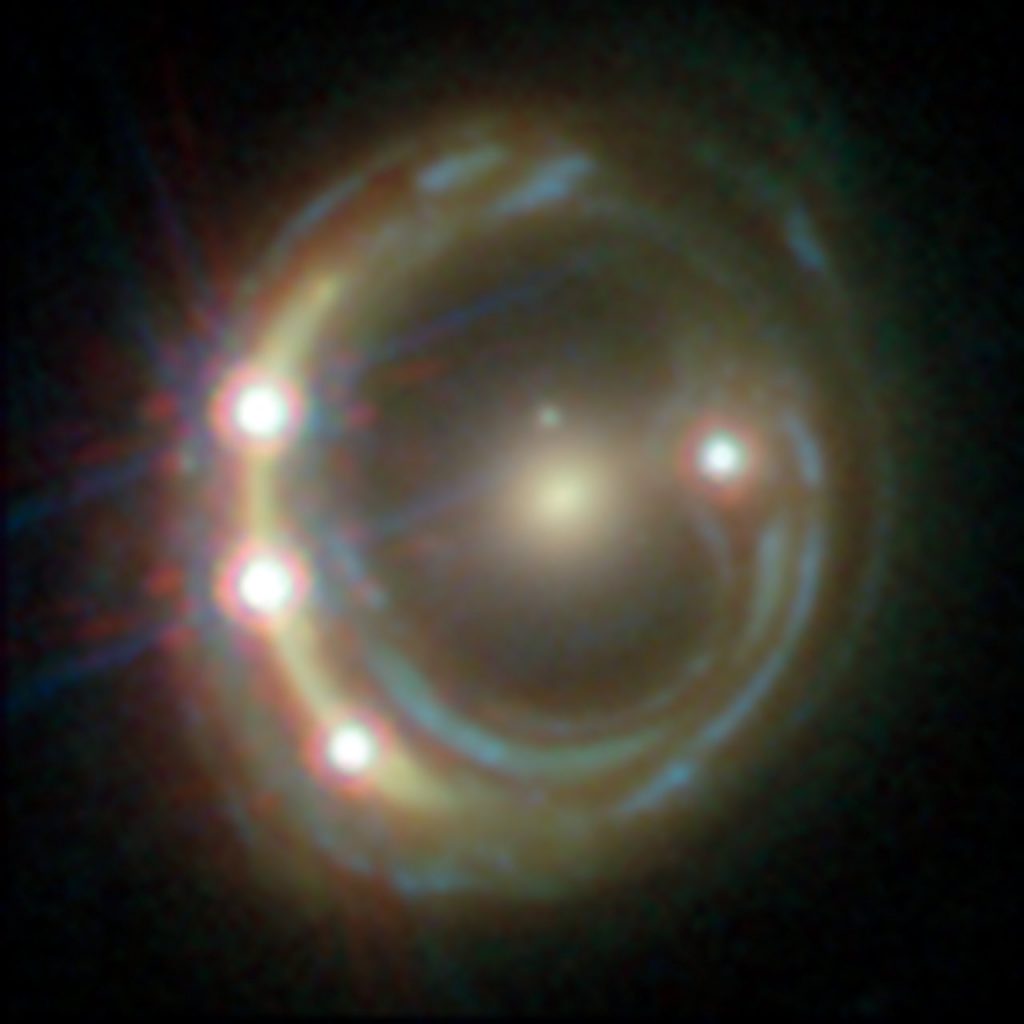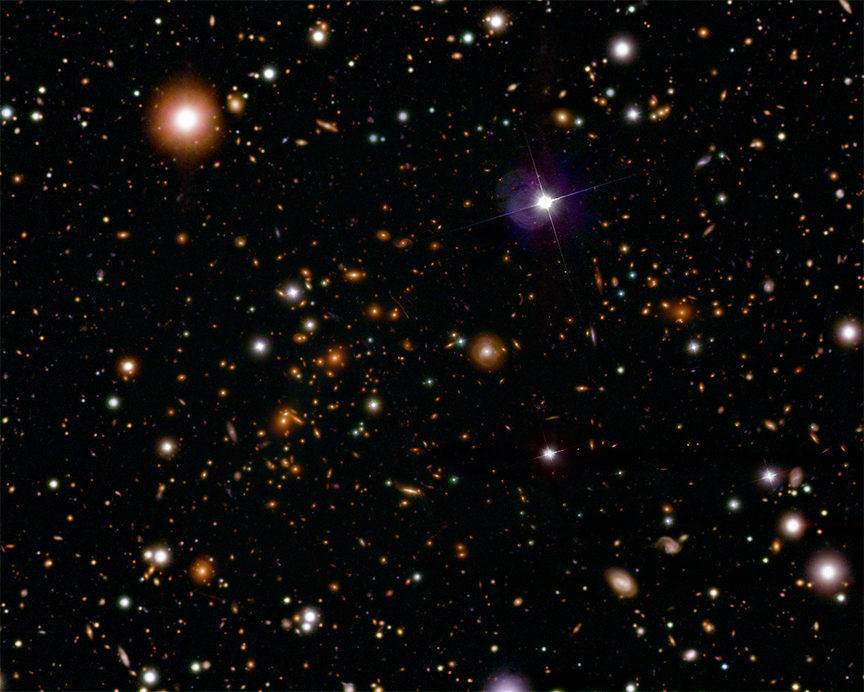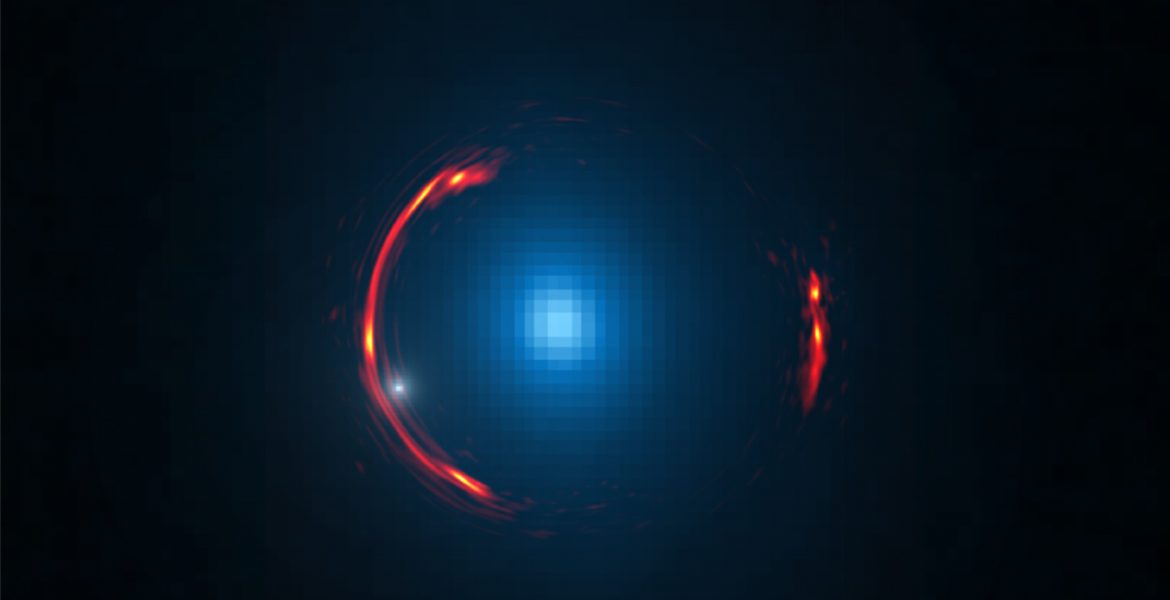Gravitational lensing picture images are available. Gravitational lensing picture are a topic that is being searched for and liked by netizens now. You can Find and Download the Gravitational lensing picture files here. Find and Download all royalty-free images.
If you’re looking for gravitational lensing picture pictures information related to the gravitational lensing picture interest, you have come to the right blog. Our site always provides you with suggestions for viewing the maximum quality video and picture content, please kindly surf and find more informative video articles and graphics that match your interests.
The transformation can be split into two terms the convergence and shearthe convergence term magnifies the background objects by increasing their size and the shear term stretches them tangentially around the foreground mass. Today it is used to study many phenomena and objects in the distant universe. Hubbles sensitivity and high resolution allow it to see faint and distant gravitational lenses that cannot be detected with ground based telescopes whose images are blurred by the earths atmosphere. A gravitational lens is a distribution of matter such as a cluster of galaxies between a distant light source and an observer that is capable of bending the light from the source as the light travels towards the observerthis effect is known as gravitational lensing and the amount of bending is one of the predictions of albert einsteins general theory of relativity. By evaluating the strong lensing phenomenon astronomers can look to the early universe dominated mostly by quasars.
Gravitational Lensing Picture. Much of the attention in gravitational lensing has been centered on microlensing and weak lensing but there have been some use of the strong lens in helping to solve the dark matter mystery. Gravitational lens as observed by the hubble space telescopein this picture a galactic cluster about five billion light years away produces a tremendous gravitational field that bends light around it. While gravitational lensing has existed throughout history its fairly safe to say that it was first discovered in the early 1900s. Nasas hubble space telescope captured the first ever picture of a group of five star like images of a single distant quasar.
 What Is Gravitational Lensing Its Discovery Mechanics And From owlcation.com
What Is Gravitational Lensing Its Discovery Mechanics And From owlcation.com
The transformation can be split into two terms the convergence and shearthe convergence term magnifies the background objects by increasing their size and the shear term stretches them tangentially around the foreground mass. Much of the attention in gravitational lensing has been centered on microlensing and weak lensing but there have been some use of the strong lens in helping to solve the dark matter mystery. Nasas hubble space telescope captured the first ever picture of a group of five star like images of a single distant quasar. Gravitational lensing acts as a coordinate transformation that distorts the images of background objects usually galaxies near a foreground mass. Refsdal establishes the quasi newtonian approximation formalism for lensing. Gravitational lens as observed by the hubble space telescopein this picture a galactic cluster about five billion light years away produces a tremendous gravitational field that bends light around it.
Gravitational lensing acts as a coordinate transformation that distorts the images of background objects usually galaxies near a foreground mass.
Today it is used to study many phenomena and objects in the distant universe. Gravitational lensing acts as a coordinate transformation that distorts the images of background objects usually galaxies near a foreground mass. A gravitational lens is a distribution of matter such as a cluster of galaxies between a distant light source and an observer that is capable of bending the light from the source as the light travels towards the observerthis effect is known as gravitational lensing and the amount of bending is one of the predictions of albert einsteins general theory of relativity. A gravitational lens is created when a massive object like a black hole or galaxy cluster falls in between an observer like the hubble telescope and a more distant target in the background. Gravitational lens as observed by the hubble space telescopein this picture a galactic cluster about five billion light years away produces a tremendous gravitational field that bends light around it. Hubbles sensitivity and high resolution allow it to see faint and distant gravitational lenses that cannot be detected with ground based telescopes whose images are blurred by the earths atmosphere.
 Source: news.berkeley.edu
Source: news.berkeley.edu
He comes to an encouraging result and starts searching in the sky for double galaxies as candidates for gravitational lensing but without success. Gravitational lens as observed by the hubble space telescopein this picture a galactic cluster about five billion light years away produces a tremendous gravitational field that bends light around it. Hubbles sensitivity and high resolution allow it to see faint and distant gravitational lenses that cannot be detected with ground based telescopes whose images are blurred by the earths atmosphere. Stars and planets can cause gravitational lensing effects although those are hard to detect. This lens produces multiple copies of a blue galaxy about twice as distant.
 Source: physicstoday.scitation.org
Source: physicstoday.scitation.org
The gravitational fields of galaxies and. Hubbles sensitivity and high resolution allow it to see faint and distant gravitational lenses that cannot be detected with ground based telescopes whose images are blurred by the earths atmosphere. Nasas hubble space telescope captured the first ever picture of a group of five star like images of a single distant quasar. Stars and planets can cause gravitational lensing effects although those are hard to detect. This effect called gravitational lensing is only visible in rare cases and only the best telescopes can observe the related phenomena.
 Source: NdT6ok2mHwyc3M
Source: NdT6ok2mHwyc3M
Gravitational lens as observed by the hubble space telescopein this picture a galactic cluster about five billion light years away produces a tremendous gravitational field that bends light around it. Much of the attention in gravitational lensing has been centered on microlensing and weak lensing but there have been some use of the strong lens in helping to solve the dark matter mystery. The gravitational fields of galaxies and. A gravitational lens is created when a massive object like a black hole or galaxy cluster falls in between an observer like the hubble telescope and a more distant target in the background. Refsdal establishes the quasi newtonian approximation formalism for lensing.
 Source: skyatnightmagazine.com
Source: skyatnightmagazine.com
This lens produces multiple copies of a blue galaxy about twice as distant. The transformation can be split into two terms the convergence and shearthe convergence term magnifies the background objects by increasing their size and the shear term stretches them tangentially around the foreground mass. Today it is used to study many phenomena and objects in the distant universe. The multiple image effect is produced by a process called gravitational lensing in which the gravitational field of a massive object bends and amplifies light from an object farther behind it. The light from the quasars is bent around the huge masses of the galaxies as a result of strong gravitational lensing.
 Source: epfl.ch
Source: epfl.ch
The gravitational fields of galaxies and. By evaluating the strong lensing phenomenon astronomers can look to the early universe dominated mostly by quasars. The gravitational fields of galaxies and. Gravitational lens as observed by the hubble space telescopein this picture a galactic cluster about five billion light years away produces a tremendous gravitational field that bends light around it. It is based on the assumptions that gravitational elds are weak and that bending angles are.
 Source: 1j4qL2cdLtq01M
Source: 1j4qL2cdLtq01M
A gravitational lens is a distribution of matter such as a cluster of galaxies between a distant light source and an observer that is capable of bending the light from the source as the light travels towards the observerthis effect is known as gravitational lensing and the amount of bending is one of the predictions of albert einsteins general theory of relativity. By evaluating the strong lensing phenomenon astronomers can look to the early universe dominated mostly by quasars. Refsdal establishes the quasi newtonian approximation formalism for lensing. This lens produces multiple copies of a blue galaxy about twice as distant. A gravitational lens is a distribution of matter such as a cluster of galaxies between a distant light source and an observer that is capable of bending the light from the source as the light travels towards the observerthis effect is known as gravitational lensing and the amount of bending is one of the predictions of albert einsteins general theory of relativity.
 Source: scienceblogs.com
Source: scienceblogs.com
Refsdal establishes the quasi newtonian approximation formalism for lensing. It is based on the assumptions that gravitational elds are weak and that bending angles are. The transformation can be split into two terms the convergence and shearthe convergence term magnifies the background objects by increasing their size and the shear term stretches them tangentially around the foreground mass. The multiple image effect is produced by a process called gravitational lensing in which the gravitational field of a massive object bends and amplifies light from an object farther behind it. This effect called gravitational lensing is only visible in rare cases and only the best telescopes can observe the related phenomena.

While gravitational lensing has existed throughout history its fairly safe to say that it was first discovered in the early 1900s. Nasas hubble space telescope captured the first ever picture of a group of five star like images of a single distant quasar. Hubbles sensitivity and high resolution allow it to see faint and distant gravitational lenses that cannot be detected with ground based telescopes whose images are blurred by the earths atmosphere. He comes to an encouraging result and starts searching in the sky for double galaxies as candidates for gravitational lensing but without success. This effect called gravitational lensing is only visible in rare cases and only the best telescopes can observe the related phenomena.
 Source: public.nrao.edu
Source: public.nrao.edu
Gravitational lensing acts as a coordinate transformation that distorts the images of background objects usually galaxies near a foreground mass. A gravitational lens is a distribution of matter such as a cluster of galaxies between a distant light source and an observer that is capable of bending the light from the source as the light travels towards the observerthis effect is known as gravitational lensing and the amount of bending is one of the predictions of albert einsteins general theory of relativity. It is based on the assumptions that gravitational elds are weak and that bending angles are. Gravitational lensing acts as a coordinate transformation that distorts the images of background objects usually galaxies near a foreground mass. Today it is used to study many phenomena and objects in the distant universe.
 Source: nGmKvfpH2-Q2dM
Source: nGmKvfpH2-Q2dM
The transformation can be split into two terms the convergence and shearthe convergence term magnifies the background objects by increasing their size and the shear term stretches them tangentially around the foreground mass. He comes to an encouraging result and starts searching in the sky for double galaxies as candidates for gravitational lensing but without success. It is based on the assumptions that gravitational elds are weak and that bending angles are. This creates multiple images of the background quasar some smeared into. The multiple image effect is produced by a process called gravitational lensing in which the gravitational field of a massive object bends and amplifies light from an object farther behind it.
 Source: xwKiEAUUa_0K-M
Source: xwKiEAUUa_0K-M
A gravitational lens is a distribution of matter such as a cluster of galaxies between a distant light source and an observer that is capable of bending the light from the source as the light travels towards the observerthis effect is known as gravitational lensing and the amount of bending is one of the predictions of albert einsteins general theory of relativity. Nasas hubble space telescope captured the first ever picture of a group of five star like images of a single distant quasar. Much of the attention in gravitational lensing has been centered on microlensing and weak lensing but there have been some use of the strong lens in helping to solve the dark matter mystery. The transformation can be split into two terms the convergence and shearthe convergence term magnifies the background objects by increasing their size and the shear term stretches them tangentially around the foreground mass. Refsdal establishes the quasi newtonian approximation formalism for lensing.
This site is an open community for users to share their favorite wallpapers on the internet, all images or pictures in this website are for personal wallpaper use only, it is stricly prohibited to use this wallpaper for commercial purposes, if you are the author and find this image is shared without your permission, please kindly raise a DMCA report to Us.
If you find this site helpful, please support us by sharing this posts to your own social media accounts like Facebook, Instagram and so on or you can also save this blog page with the title gravitational lensing picture by using Ctrl + D for devices a laptop with a Windows operating system or Command + D for laptops with an Apple operating system. If you use a smartphone, you can also use the drawer menu of the browser you are using. Whether it’s a Windows, Mac, iOS or Android operating system, you will still be able to bookmark this website.





